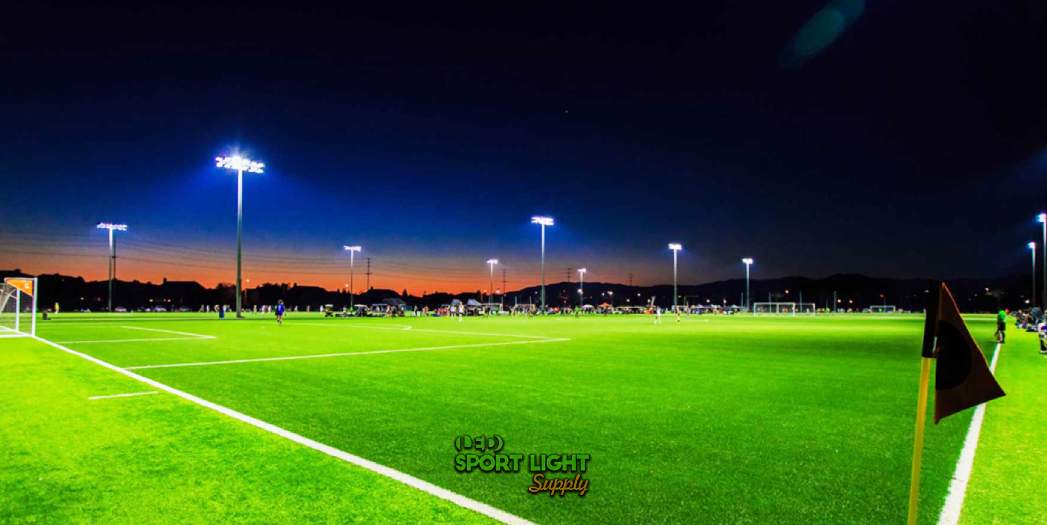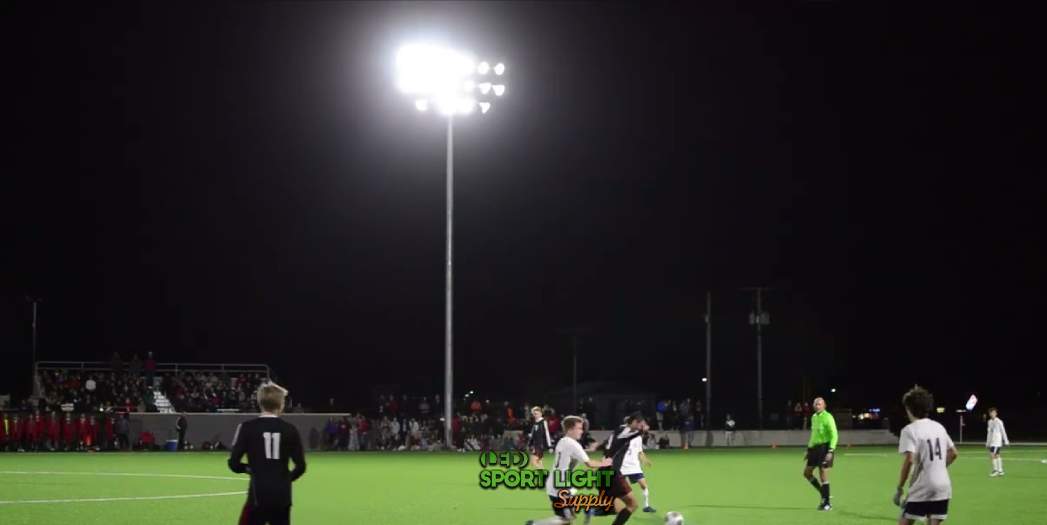The right lighting transforms a soccer field into a canvas of precision, enhancing visibility, player performance, and spectator enjoyment. As soccer continues to captivate hearts globally, the demand for high-quality, reliable, and effective lighting solutions has never been greater.
Table of Contents
ToggleLED lighting has revolutionized sports field illumination, offering exceptional energy efficiency compared to traditional lighting technologies. LEDs consume significantly less power while delivering equivalent or superior light output, leading to cost savings on electricity bills and a reduced environmental footprint. Their longer lifespan also means less frequent replacements and lower maintenance costs, making them a highly economical choice for soccer fields.
One of the most significant attributes of LED lights is their ability to produce high-quality, uniform light. Soccer fields require precise lighting to ensure that every inch of the playing surface is well-illuminated. LED technology provides consistent brightness levels across the entire field, minimizing dark spots and shadows that can affect gameplay. This uniformity is crucial for maintaining a fair playing field and ensuring that players can perform at their best.

Uneven lighting can create significant issues on the field. Areas with excessive glare can impair players’ vision, making it difficult for them to track the ball or anticipate movements. Conversely, shadowed regions can obscure parts of the field, leading to missed passes or unexpected obstacles. Such inconsistencies can affect the flow of the game and potentially influence its outcome, highlighting the need for a well-planned lighting strategy.
To achieve optimal uniformity in soccer field lighting, several key factors must be considered. Strategic placement of lighting fixtures plays a critical role in achieving even illumination. Fixtures need to be positioned to cover all areas of the field without creating hotspots or dark spots. This often involves a combination of high-mounted lights and well-planned angles to ensure comprehensive coverage.
Proper calibration of lighting fixtures is essential to balance light distribution. This includes adjusting the intensity and angle of each fixture to minimize glare and ensure that light is evenly spread across the field. Advanced lighting control systems can aid in fine-tuning these settings for optimal performance.
The choice of lighting fixtures also impacts uniformity. Modern LED fixtures are often preferred for their ability to provide consistent and adjustable illumination. These fixtures can be tailored to meet specific lighting requirements and are less prone to issues like flickering or color shift.
Maintaining uniformity requires ongoing upkeep, including regular inspections and maintenance of lighting fixtures. Addressing issues such as dirt accumulation or bulb degradation helps ensure that light distribution remains consistent. Ensuring that all fixtures are functioning correctly is vital for maintaining a uniform lighting environment.

Lighting design for soccer fields must address the lux requirements to ensure appropriate illumination levels for various types of play. The International Football Association Board (IFAB) sets specific standards for professional and broadcast-quality games. According to IFAB guidelines, a minimum of 1,200 lux is required to provide optimal visibility for players, referees, and spectators. This high level of illumination is essential for professional matches where clarity and detail are critical for live broadcasts and high-stakes competition.
For recreational or amateur matches, the lighting requirements can be more flexible. Lower lux levels may be acceptable, typically ranging between 300 to 500 lux, depending on the level of play and the field’s use. However, regardless of the lux level, maintaining uniformity across the field is crucial to avoid areas of excessive brightness or darkness, which can impact the game’s fairness and player performance.
Achieving the desired illumination on a soccer field requires careful planning of fixture placement and arrangement. Modern soccer fields typically utilize a combination of pole-mounted fixtures and floodlights. The strategic placement of these fixtures is essential for ensuring even light distribution and minimizing shadows.
Pole-mounted fixtures are commonly used to provide overhead illumination. They are positioned at various points around the field and are often adjustable to optimize lighting angles. The height and positioning of these poles are calculated to cover the entire field uniformly, preventing dark spots and ensuring that all areas are well-lit.
Floodlights are used to provide focused and intense illumination. They are often mounted on tall poles or towers and directed towards the field. The placement of floodlights must be carefully planned to achieve even lighting across the playing surface while minimizing glare for players and spectators. The angle of the floodlights is adjusted to avoid direct light interference and ensure that the field is illuminated without creating harsh shadows.
Soccer fields are exposed to various weather conditions, from intense sunlight to heavy rain and freezing temperatures. Therefore, the durability and weather resistance of lighting fixtures are paramount. LED lights are particularly well-suited for outdoor sports environments due to their robust construction and ability to withstand harsh conditions. High-quality LED fixtures are rated for outdoor use and designed to endure moisture, dust, and temperature fluctuations.
Many LED sports lighting systems are equipped with IP (Ingress Protection) ratings, indicating their resistance to water and dust ingress. Fixtures with a high IP rating, such as IP65 or higher, are recommended for reliable performance in adverse weather conditions. Additionally, the housing of LED fixtures is often constructed from durable materials like aluminum or stainless steel, providing resistance to corrosion and impact.
Glare is a common issue in sports lighting that can significantly impact player performance and spectator experience. Excessive glare can cause discomfort and visual impairment, making it difficult for players to track the ball and for spectators to enjoy the game. Modern soccer field lighting systems incorporate design elements and technologies to mitigate glare effectively.
One effective approach is the use of anti-glare shields and diffusers, which direct light where it’s needed and reduce the intensity of light that is scattered or reflected. High-quality LED fixtures often feature advanced optics that improve light distribution and reduce glare. Proper fixture positioning and angling are also critical, ensuring that light is directed onto the field without creating uncomfortable glare for players or viewers.
For professional soccer fields, lighting design must meet stringent standards to ensure high-quality play and broadcast. These fields require a minimum of 1,200 lux to support high-definition broadcasts and competitive play. The lighting system typically includes multiple high-intensity floodlights mounted on tall poles surrounding the field. These fixtures are arranged to provide even coverage and minimize shadows, with careful consideration given to glare reduction and uniformity.
Amateur and recreational soccer fields have less demanding lighting requirements compared to professional fields. While lower lux levels (around 300-600 lux) may be acceptable, achieving uniform lighting remains important. Fixture placement may be less complex, with fewer poles and floodlights used to provide adequate illumination. The focus is on ensuring that the field is well-lit for players and spectators without the need for high-intensity lighting systems.
Training and practice fields often require versatile lighting solutions that can adapt to various activities and times of day. These fields may use lower lux levels compared to competitive fields but still require uniform coverage to support effective training sessions. Adjustable LED floodlights and smart lighting systems can provide flexibility in illumination levels and coverage, making them ideal for training environments.
In today’s environmentally conscious world, energy efficiency and sustainability are key considerations in sports lighting. LED lighting is a natural choice for soccer fields due to its low energy consumption and minimal environmental impact. LEDs generate less heat compared to conventional lighting technologies, requiring less energy for cooling and having a lower overall environmental footprint.
Many soccer fields are now adopting energy-efficient lighting solutions as part of broader sustainability initiatives. Some facilities incorporate solar panels or other renewable energy sources to power their lighting systems, further enhancing their environmental credentials. By embracing LED technology and sustainable practices, sports venues can achieve both operational efficiency and environmental responsibility.
Maintenance is a crucial aspect of sports field lighting, ensuring that the system remains in optimal working condition throughout its lifespan. LED lighting offers several advantages in this regard, including lower maintenance requirements and longer service life. LEDs have an average lifespan of 50,000 hours or more, significantly reducing the frequency of maintenance interventions and associated costs.
To further enhance the longevity of soccer field lighting systems, regular inspections and maintenance are recommended. Routine checks can identify potential issues such as fixture misalignment, lens cleanliness, and electrical connections. Addressing these issues promptly helps maintain the system’s performance and ensures that the field remains well-lit for players and spectators alike.
LED lighting has fundamentally transformed soccer field illumination, offering unparalleled energy efficiency, high-quality light output, and durability. By achieving optimal uniformity, addressing glare, and meeting specific lux requirements, LED technology ensures that soccer fields are lit to enhance gameplay and viewing experiences. From professional arenas to recreational and training fields, the adaptability and sustainability of LED systems make them an essential choice for modern sports facilities. As technology continues to evolve, the benefits of LED lighting will undoubtedly contribute to better, more environmentally conscious sports environments.
Drop us a line to receive a free lighting design